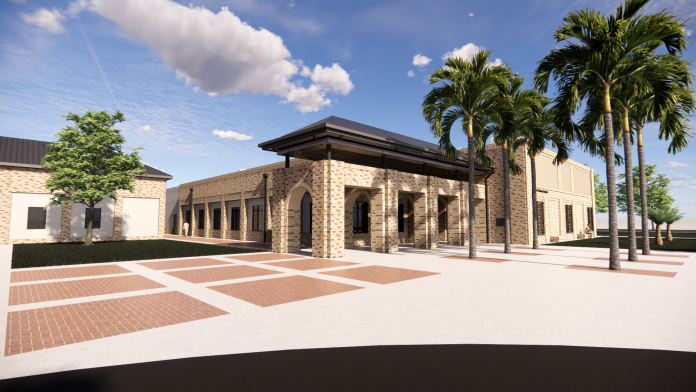
This architectural rendering shows what the Center for Human Genetics on UTRGV’s Brownsville campus will look like when complete. The new facility is expected to open Jan. 12, 2023.PHOTO COURTESY UT SYSTEM
|
Only have a minute? Listen instead
Getting your Trinity Audio player ready...
|
The Department of Human Genetics of the South Texas Diabetes and Obesity Institute on the University of Texas Rio Grande Valley Brownsville campus is getting its own building, the Center for Human Genetics, which will allow the institute to expand its cutting-edge medical research even further.
That’s according to Dr. Sarah Williams-Blangero, chair of the department and director of the institute. The former chair of the Department of Genetics at the Texas Biomedical Research Institute in San Antonio, she came to Brownsville in 2014 to establish the Diabetes and Obesity Institute, bringing 21 other researchers and support staff with her.
“We had had a heavy focus on cardiovascular disease and diabetes in Mexican Americans and other minority populations, so this was just an ideal setting for us to work at, and of course the excitement of the development of the new medical school and all of that, made it very attractive to come down here,” Williams-Blangero said.
The institute has been focused on identifying genes that influence risk for diabetes, obesity and cardiovascular disease, she said. Such research takes time, though the ultimate goal is to reveal how new drugs can be developed — or existing drugs used in new applications — to combat those diseases, Williams-Blangero said.
“We’ve made progress on identifying novel genes influencing risk for diabetes and obesity while we’ve been here,” she said. “We have expanded our recruitment locally, so we have about 650 individuals from the Rio Grande Valley who are now participating in our studies. That’s been kind of our progress to date.”
In 2017 the institute’s core faculty founded the Department of Human Genetics. The new center will mean capabilities and a greater impact on the Valley from the center’s research, Williams-Blangero said.
“This building will encompass a Center for Imaging Genomics, so we’re going to have a dedicated MRI that’s for research and will allow us to branch into brain-related disorders, liver disease — a wide range of areas where imaging is important,” she said. “We have done imaging genomic studies in the past, but we’ve had to do that work up in San Antonio because we didn’t have the facilities here in the Valley to do that, so this will dramatically expand of what we can do locally.”
Genomics is the study of an individual’s complete DNA, including genes.
The Center for Human Genetics will also a feature a vivarium that will house the department’s “very unusual colony of laboratory opossums,” Williams-Blangero said. The department has 1,200 of the small South American opossum, roughly the size of a gerbil, on hand at any given time for various types of research, she said.
“This new facility will allow us to dramatically expand the work we’re doing with those animals too, and then we have laboratory space in there that will be for genetics and proteomics work and office space, so we’re hugely excited about the building,” Williams-Blangero said.
Proteomics is the large-scale study of proteins.
Besides expanded research capabilities, the new building will provide some much needed addition space for people and new equipment, Williams-Blangero said.
“We are kind of bursting at the seams in terms of people right now, and so this will allow us to accommodate our staff and faculty in adequate office space, and also will allow expansion of the laboratory work,” she said. “Plus we have a Ph.D. program that is launching in the fall that will train new human geneticists, and that space also will be used as laboratory space for the students to work in.”
The department currently has 19 faculty and 52 people all together, and is in the process of recruiting three new faculty members, Williams-Blangero said.
The $15.8 million project is being made possible by a $6 million grant from the Valley Baptist Legacy Foundation, specifically for the MRI equipment at the heart of the Center for Imaging Genomics, and almost $9 million from the Permanent University Fund. The latest estimate for an opening date is Jan. 12, 2023, Williams-Blangero said.
As much as the new center’s research is expected to affect the Valley, it doesn’t end there, she said.
“It’s useful to realize that this has an impact way beyond the Valley,” Williams-Blangero said. “We collaborate with over 90 institutions around the world and so this network of research collaboration really does have a very broad impact.”



